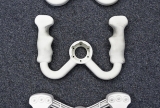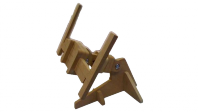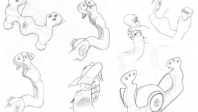or ‘How Hard Can It Be to Drive In a Straight Line?’
by Andy Green
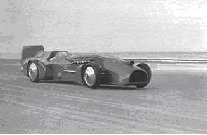 ‘I had one hell of a job keeping the car on course’
‘I had one hell of a job keeping the car on course’
Sir Malcolm Campbell Daytona Beach, 1933
Driving across the uneven surface of Daytona Beach in 1933, struggling to control over 2000 hp driving through the rear wheels of his ‘Bluebird’ car, it is easy to imagine why Sir Malcolm Campbell found it to be ‘one hell of a job’. But with jet- and rocket-powered vehicles no longer driving through the wheels, and running on the much smoother surfaces of Bonneville Salt Flats or the Black Rock Desert, why is steering a problem? Indeed, as I have been asked several times in the past, why have steering at all – can’t you just fix the wheels straight ahead and go for it?
The steering has to cope with a number of factors that try to push a high-speed car off line:
• Surface. While Bonneville and Black Rock are relatively smooth, they are still ‘off road’ natural surfaces and have slight irregularities. Working on the assumption that there’s no such thing as a ‘small bump’ at 1000 mph, any slight change in surface hardness, drag or level can have a huge effect on the Car. The suspension can allow for some of this but a change in surface drag, for instance, can rapidly pull the Car off line.
• Wind. The wind can change dramatically over a track distance of 12 miles – it can be flat calm at one end and kite flying weather at the other. Consider this: a 5 kph (3 mph) wind is the same speed as a very slow walk, it’s the slightest of breezes. Yet 5 kph is over 80 metres per minute – so a 5 kph crosswind would blow the Car over 160 metres off line in the 2 minutes that a BLOODHOUND run will take. And crosswinds of a lot more than 5 kph can spring up from nowhere during a 12 mile run…
• Car Aerodynamics. As the Car accelerates through about Mach 0.85 (i.e. 85% of the speed of sound – about 650 mph), it starts to become ‘transonic’. That means that the airflow starts to go supersonic in localised areas, wherever it has to accelerate by more than 15%, for example where it is forced under the Car, over the cockpit, etc.). This mix of supersonic and subsonic flow will depend on the exact shape of the Car and may not be perfectly symmetrical – in Thrust SSC’s case, for instance, it caused the load on the front wheels to be over ½ tonne more on one side that the other, due to tiny differences in the shape of the Car.
• Stability Changes. At low speed, the sideways grip from the wheels is a major influence on the directional stability of the Car. However, this wheel stability reduces as the speed increases. The aerodynamic stability builds up with the square of speed (aerodynamic forces at 1000 mph are 100 times greater than the forces at 100 mph) and will eventually compensate, but only at high speed. In the mid-speed range, the Car is likely to suffer from reduced directional stability at some point in the run, as most record cars tend to do. For example, novice drivers at Bonneville can be caught out by this effect – it is not unusual to see cars spin at well over 100 mph. This reduced stability effect will be exacerbated by large dynamic changes, such as the firing of a 25,000 lb thrust rocket!
• Emergencies. BLOODHOUND SSC is being built to avoid or minimise every conceivable emergency. However, it is not realistic to say that ‘nothing can go wrong’, and I wouldn’t believe anyone that did. For instance, a small failure of the rocket nozzle could produce a significant off-axis (i.e. sideways) thrust – if 25 000lb of rocket thrust gets even a little bit ‘off-axis’, the Car is going to know all about it. While the rocket will shut itself down within a fraction of a second, the Car may be some way off heading by then.
Looking at the above list, there seems to be quite a lot that the steering may have to deal with. At this speed, why don’t we use a rudder like an aircraft, and not bother to turn the wheels? A rudder will work well at high speed, but also depends on aerodynamic forces: its effectiveness at 100 mph is again only 1/100th of its effectiveness at full speed. We could try to change the response of the rudder with speed – but this is now starting to become a complicated solution for a safety-critical system. In any case, if the wheels are providing enough lateral grip, that should provide an effective way to steer… and if the wheels are not providing enough lateral grip, is the Car really safe to run?
How about automated steering, or some kind of ‘fly-by-wire’ computer stabilisation? No – the rules do not allow it, and quite right too in my opinion. In order to be a land vehicle in LSR terms, the FIA rules require that the vehicle is ‘wholly and continuously controlled by the driver’. Even if the rules did allow for a computer system, should we really be running a car that needs a computer (which will be untested in this prototype vehicle) to keep it safe?
So how much steering input is going to be needed? The choice of range is huge – from a conventional road car (at around 15:1 – i.e. 15 degrees of steering wheel movement turns the road wheels by 1 degree) to a tiny amount just to trim small movements (a steering ratio of perhaps 100:1). The road car steering of 15:1 is likely to be far too ‘direct’ and sensitive at high speeds. At the other end of the scale, several LSR cars have used very high ratio steering, such as Gary Gabelich’s Blue Flame, which used a ratio of 91:1.
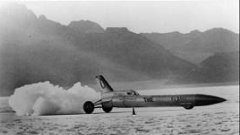 Gary Gabelich on the way to a 622 mph Land Speed Record in the Blue Flame
Gary Gabelich on the way to a 622 mph Land Speed Record in the Blue Flame
Such a high steering ratio is fine if everything goes well, there is little or no crosswind and the surface is near-perfect. However, if the Blue Flame had been pushed significantly off line for any reason, could Gary have coped within the limited response available on a 91:1 steering ratio? We have no way of knowing, but I’d rather not find out.
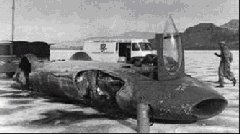 Donald Campbell’s Bluebird crashed at Bonneville in 1960.
Donald Campbell’s Bluebird crashed at Bonneville in 1960.
Another useful case study is Donald Campbell’s Bluebird CN7. The car initially ran with a steering ratio of 25:1, but Campbell found this too direct for him. As a result, the ratio was raised dramatically to 100:1, whereupon Campbell reported that the car had ‘a tendency to wander’. On a subsequent test run, Campbell lost control altogether and the car was wrecked. During the rebuild, Bluebird’s steering ratio was lowered again to 33:1 and left at that figure.
More recently, Thrust 2 ran with a 25:1 steering while Thrust SSC used a 30:1 ratio. Richard Noble needed a fair bit of steering in the early days of Thrust 2, running on the salt at Bonneville, while Thrust SSC needed all of its steering capability to stay on course in the Black Rock Desert in 1997:
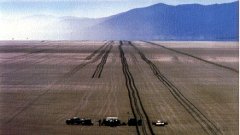 As you can see by looking down the tracks, the combination of transonic flow differences, rear wheel steering, surface irregularities, cross winds, etc., etc., caused TSSC to move up to 15 metres or more off line at times – and that was with up to 90 degrees of steering input to try to correct it! Thrust SSC’s 30:1 steering ratio was just enough to control the Car.
As you can see by looking down the tracks, the combination of transonic flow differences, rear wheel steering, surface irregularities, cross winds, etc., etc., caused TSSC to move up to 15 metres or more off line at times – and that was with up to 90 degrees of steering input to try to correct it! Thrust SSC’s 30:1 steering ratio was just enough to control the Car.
While we are all hoping (me more than most!) that BLOODHOUND SSC will be substantially easier to control than Thrust SSC was, we are planning for all eventualities. Hence BLOODHOUND SSC will also start with a steering ratio of around 30:1, with the option to increase the ratio (and thus decrease the steering response) later if required. After all, how hard can it be to drive in a straight line?

